Oil stains have a sneaky way of showing up when you least expect them—maybe from cooking in the kitchen, working long shifts in a hospital, or accidentally stepping into a greasy spot at the garage.
The frustrating part? It’s not easy to remove oil stains from shoes. Because oil doesn’t just wipe away like dirt.
But here’s the good news: knowing how to remove oil stains from shoes quickly and the right way can save your favorite pairs from permanent damage and keep them looking fresh and clean.
Removing Oil Stains From Shoes- Why It’s Hard?
Have you ever noticed how oil stains just seem to cling stubbornly to your shoes, refusing to budge no matter how much you scrub? That’s because oil isn’t like regular dirt—it’s sneaky. Instead of sitting on the surface, it seeps deep into the tiny fibers of fabric or the pores in leather, making those stains really hard to get out.
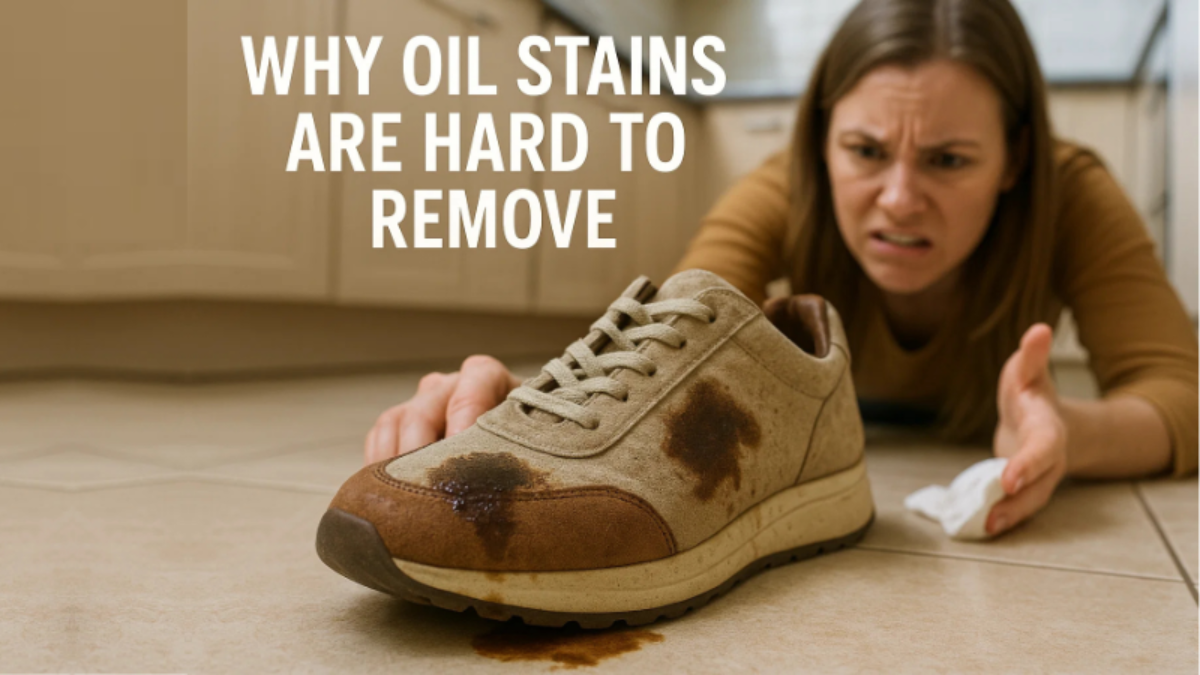
Think of porous materials like fabric or suede as little sponges—they soak up the oil quickly, which means the stain sets almost instantly. That’s why a quick wipe with water often won’t do the trick.
And here’s another catch: grease leaves behind dark, persistent spots that are much more noticeable than dirt. If you’re not careful with how you clean, you might accidentally spread the stain further or even damage the delicate finish of your shoes.
So, what’s the takeaway? Using the right cleaning method tailored to your shoe’s material isn’t just a good idea—it’s essential. Treating leather the same way you treat canvas could make things worse, but with the right approach, you can lift those stubborn stains without ruining your favorite kicks. Have you had a tricky oil stain challenge before? Let’s tackle it the right way!
Identify Your Shoe Material
Knowing what your shoes are made of is the first crucial step before you remove oil stains from shoes. Each material reacts differently to cleaning methods, so treating them the right way will save your shoes from further damage.
- Fabric/Canvas:
These materials are porous and absorb oil quickly. Because of this, using powders like baking soda or cornstarch to lift the oil before washing is essential to avoid setting the stain deeper.
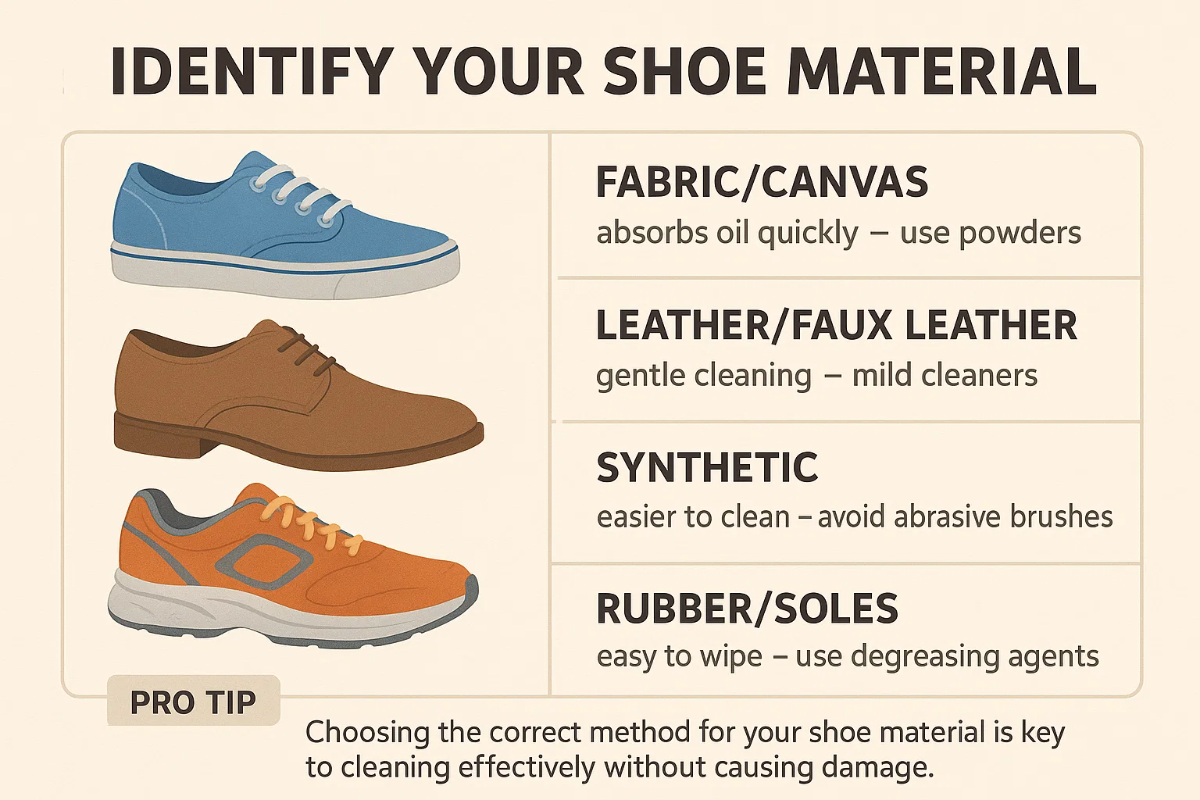
- Leather/Faux Leather:
While durable, leather can stain easily and requires gentle care. Harsh scrubbing or strong chemicals can damage the finish or cause discoloration, so opt for mild cleaners or leather-specific products.
- Synthetic Materials:
Often more forgiving, synthetics are easier to clean, but be cautious with abrasive brushes or harsh chemicals that might scratch or weaken the material.
- Rubber or Soles:
These non-porous parts tend to keep grease on the surface, making them easier to wipe clean with proper degreasing agents.
Choosing the correct method for your shoe material is key to cleaning effectively without causing damage. Have you ever tried cleaning the wrong way and ended up making a stain worse? That’s why this step is so important!
General Supplies You’ll Need to Tackle Oil Stains Like a Pro
Before you roll up your sleeves and tackle those stubborn oil stains, it’s important to have the right tools on hand. Think of these supplies as your cleaning arsenal — the key to a successful, damage-free shoe rescue mission.
1. Paper Towels or Napkins
These are your first line of defense. The moment you notice an oil stain, gently blot the area with paper towels or napkins to soak up as much excess oil as possible. Avoid rubbing — rubbing only pushes the stain deeper into the fabric or leather, making it harder to remove later. Blotting absorbs without spreading the mess.
2. Cornstarch or Baking Soda
These common kitchen staples are miracle workers when it comes to oil stains. Sprinkle a generous amount onto the stain to absorb grease from the shoe’s surface and fibers. Let it sit for at least 15-30 minutes (or even overnight for tough stains) before brushing off. This step is crucial, especially for fabric or canvas shoes, as it lifts the oil before you even get to washing.
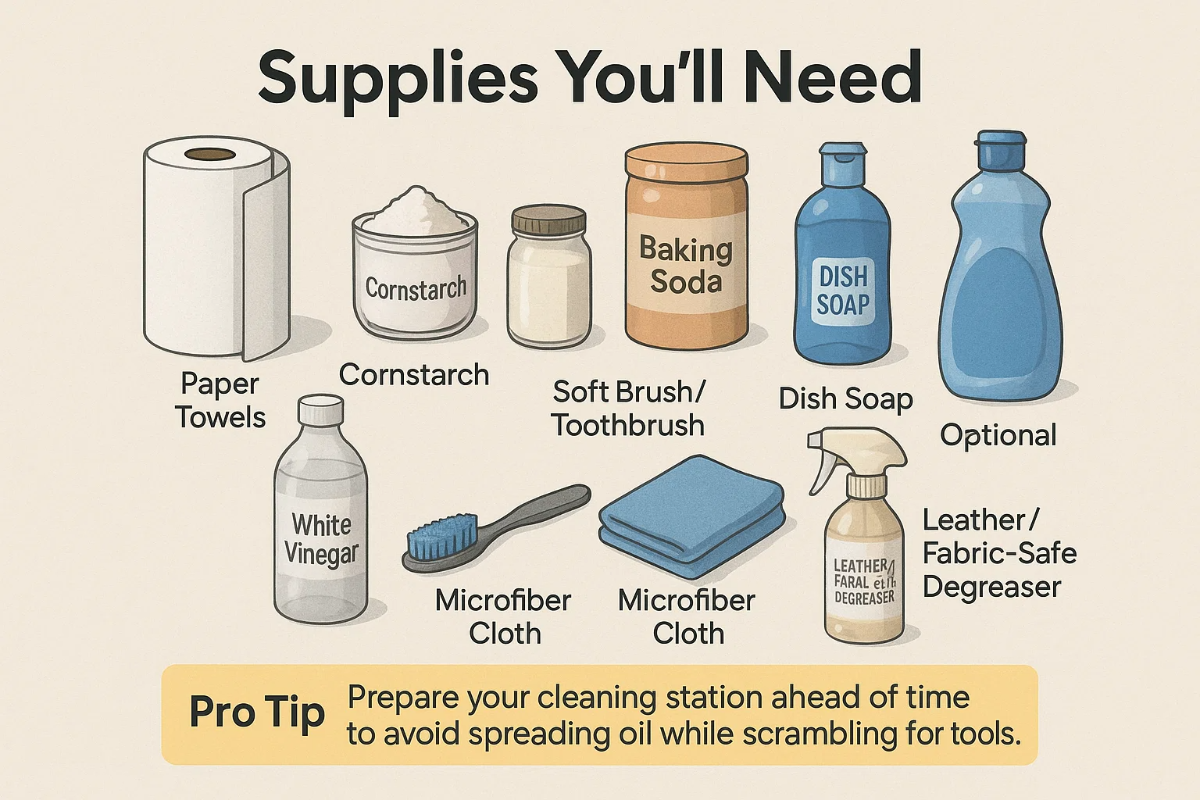
3. Dish Soap (Degreasing Type)
Dish soap is formulated to cut through kitchen grease, so it’s incredibly effective for breaking down oil stains on shoes. Choose a mild, degreasing soap that won’t harm delicate materials. Mix with warm water to create a gentle cleaning solution. This soap will help break down the oil molecules, making them easier to wipe away.
4. White Vinegar (Optional)
While vinegar isn’t a degreaser, it’s excellent for deodorizing shoes after cleaning, especially if the oil stain was particularly greasy or if the shoes have lingering odors. It also helps break down residual grime and restores brightness to faded areas. Use sparingly and test on a small area first to avoid discoloration.
5. Soft Brush or Toothbrush
A soft-bristled brush is your best friend for working cleaning solutions into the fabric without damaging it. For delicate or suede materials, a soft toothbrush works well to gently agitate the stain. Avoid stiff brushes as they can scratch or fray shoe surfaces.
6. Microfiber Cloth
After scrubbing, you’ll want a soft microfiber cloth to wipe away dirt, soap residue, and loosened oil. Its fine fibers trap dirt and moisture without scratching the shoe’s surface, which is perfect for leather or synthetic materials. Plus, it’s super absorbent and gentle.
7. Optional: Leather-Safe or Fabric-Safe Commercial Degreaser
For really tough oil stains that don’t budge with home remedies, a specialized degreaser designed for your shoe’s material can be a lifesaver. These products are formulated to break down grease effectively while protecting delicate finishes and colors. Just be sure to follow the instructions carefully and test on an inconspicuous spot first.
Pro Tip:
Prepare your cleaning station ahead of time! Lay out all these supplies on a towel or tray, so everything is within arm’s reach. This keeps your process smooth and reduces the chance of accidentally spreading oil while scrambling for tools.
Step-by-Step: How to Remove Oil Stains from Shoes
Getting oil stains out of your favorite shoes can feel tricky, but with the right steps, you can tackle them safely and effectively. Let’s break it down by shoe material to make sure you’re using the best method for your pair.
For Fabric/Canvas Shoes
Fabric and canvas are porous, which means they soak up oil quickly — but don’t worry, you can still save them without damaging the material.
1. Blot excess oil gently with a paper towel—don’t rub!
The moment you spot the stain, use a paper towel to carefully blot away as much oil as possible. Rubbing can push the oil deeper into the fibers, making the stain worse.
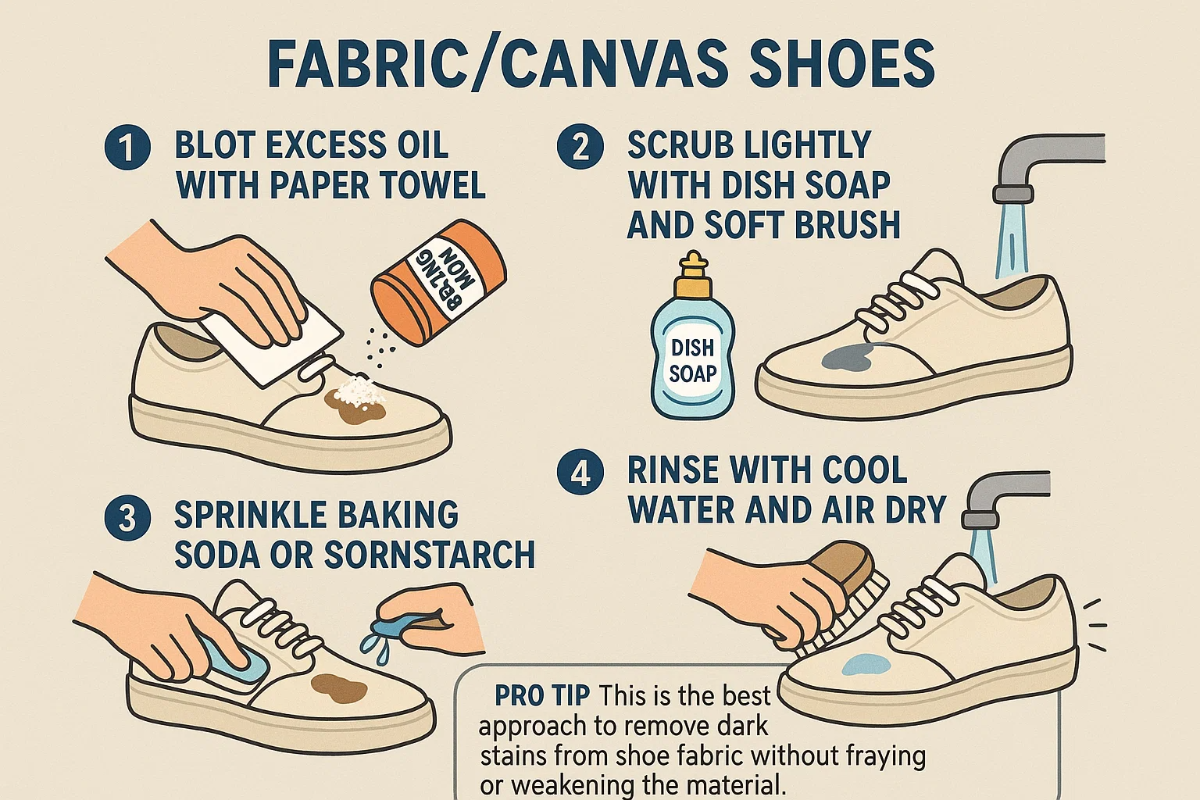
2. Sprinkle baking soda or cornstarch generously over the stain
Cover the entire oily area with a thick layer of baking soda or cornstarch. These powders act like magnets, absorbing the grease from the fabric. Let this sit for 30 to 60 minutes — or longer if you can — to soak up as much oil as possible.
3. Scrub lightly with dish soap and warm water using a soft brush
Create a gentle cleaning solution by mixing a few drops of degreasing dish soap with warm water. Use a soft-bristled brush (a toothbrush works great) to lightly scrub the stained area. This helps break down the remaining oil without damaging your shoe’s fabric.
4. Rinse with cool water and air dry
Once you’ve scrubbed, rinse the area thoroughly with cool water to remove soap and residue. Avoid hot water as it can set any leftover stain. Finally, let your shoes air dry in a well-ventilated space—never use direct heat or a dryer, as this can warp or shrink the fabric.
This is the best approach for how to remove dark stains from shoe fabric without fraying or weakening the material. Have you tried this method before?
For Leather Shoes
Leather shoes requires a gentle touch since it can stain easily or lose its finish if treated harshly.
1. Absorb oil with a paper towel as soon as possible
Quickly blot the oily spot with a paper towel to soak up as much grease as you can. The faster you act, the easier it will be to remove.
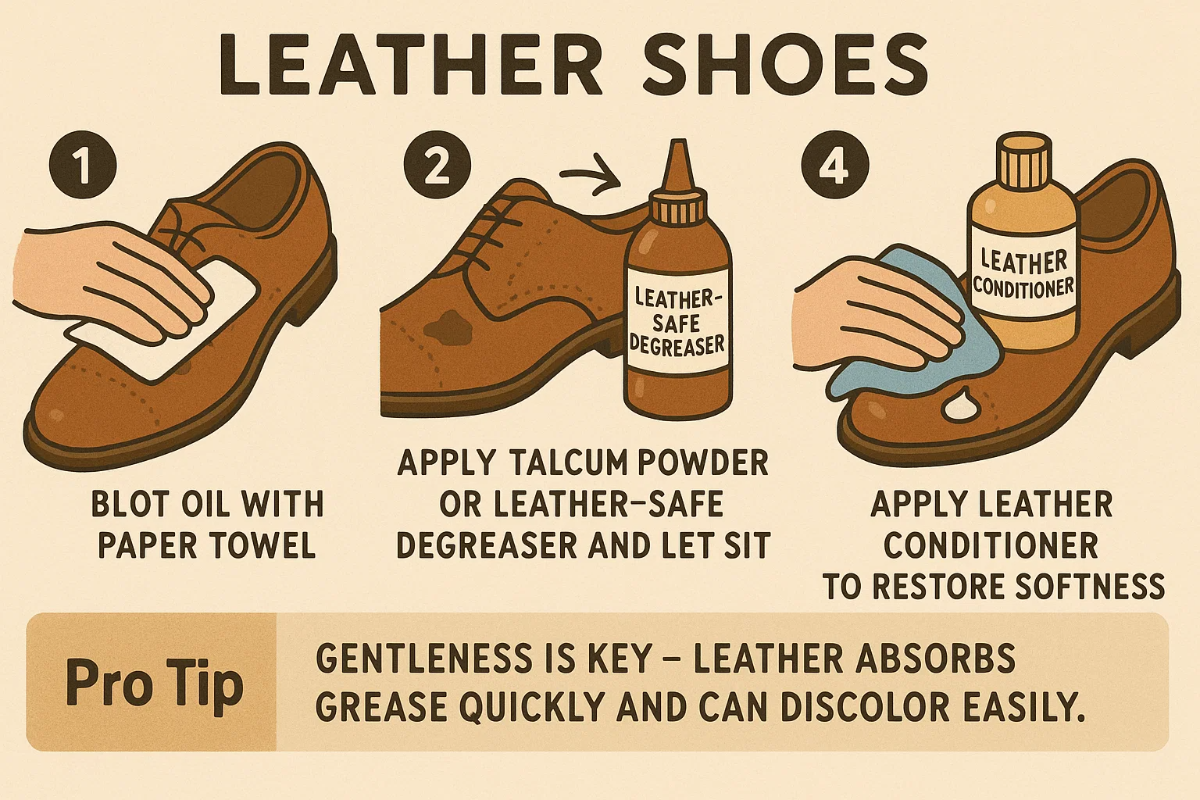
2. Apply talcum powder or a leather-safe degreaser to the spot
Cover the stain with talcum powder, cornstarch, or a specialized leather-safe degreaser. These powders pull oil out of the leather’s pores. Let it sit for at least a few hours, or overnight if possible.
3. Wipe gently with a microfiber cloth
After the powder has absorbed the oil, gently wipe it away using a soft microfiber cloth. Avoid scrubbing hard, as this can damage the leather’s surface.
4. Follow up with leather conditioner to restore softness
Once the stain is gone, apply a leather conditioner to keep your shoes supple and prevent drying or cracking. Conditioning also helps maintain the leather’s natural shine and texture.
This is considered the best method to lift oil from leather shoes without causing discoloration or damage. Have you noticed how quickly leather can soak up grease? That’s why gentleness is key here.
For Synthetic or Rubber Shoes
Synthetic materials and rubber soles are less porous, which means oil stains usually sit on the surface and are easier to clean.
1. Mix degreasing dish soap with warm water
Prepare a cleaning solution by combining warm water with a few drops of a degreasing dish soap.
2. Dip a brush in the solution and scrub the oily spot
Using a soft brush or toothbrush, scrub the oily area gently but thoroughly. This will lift the grease without harming the synthetic or rubber surface.
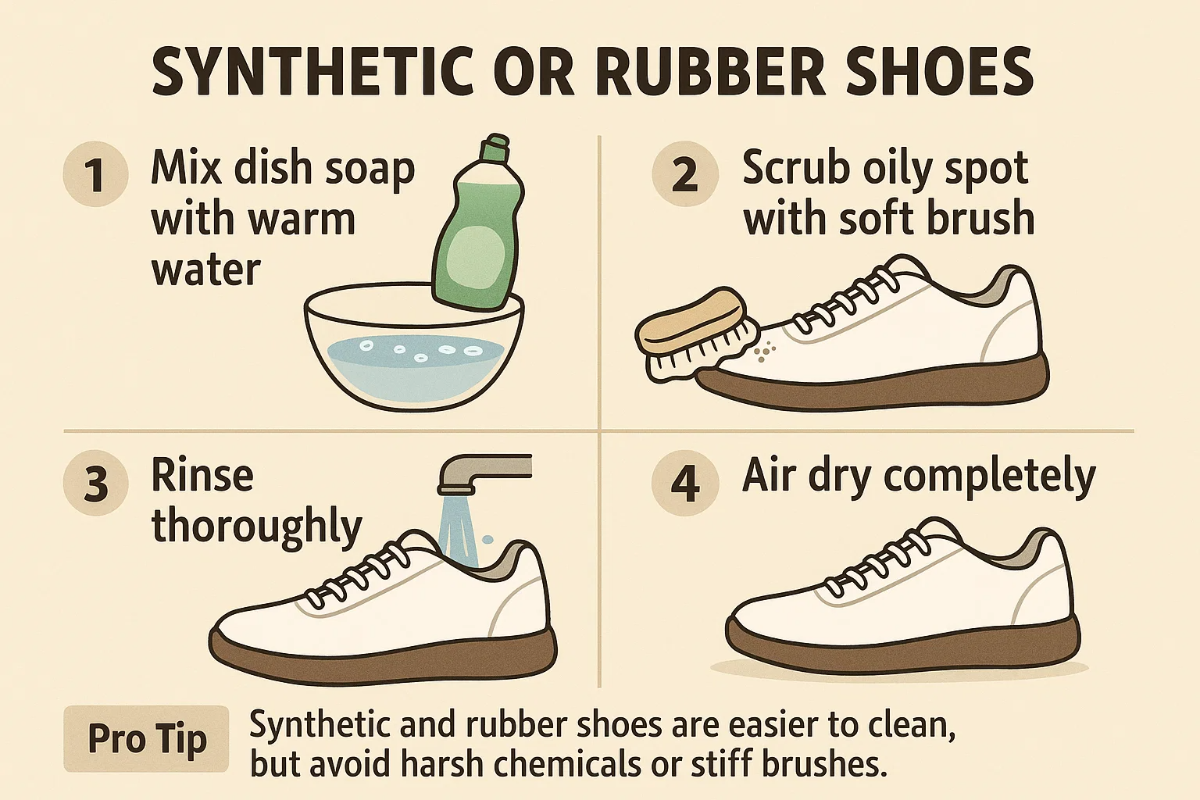
3. Rinse thoroughly and dry
Rinse the cleaned area well with water to remove soap residue. Then, allow your shoes to air dry completely.
This works well for anyone wondering how to clean grease from shoes made from man-made materials like synthetics and rubber. Did you know these materials are often the easiest to refresh?
Pro Tip:
Always test any cleaning solution on a small, hidden area of your shoe first. This helps avoid unwanted discoloration or damage. And remember, patience is key — sometimes it takes a couple of rounds to fully remove stubborn oil stains.
Home Remedy for Oil-Stained Sneakers
If you have oil stains on your sneakers and want an easy, effective way to clean them at home, using common household ingredients like baking soda and dish soap can be very helpful. This method is gentle enough to avoid damaging the fabric but strong enough to lift the grease.
Step 1: Prepare a Baking Soda and Dish Soap Paste
Begin by mixing baking soda and dish soap to form a thick paste. The baking soda acts as a mild abrasive and absorbs the oil, while the dish soap’s degreasing properties help break down and remove the grease. Use about two tablespoons of baking soda and add dish soap slowly until you get a consistency that can be spread easily but isn’t runny.
Step 2: Apply the Paste to the Stain
Using your fingers, a sponge, or a soft brush, apply the paste generously over the oil-stained area of your sneaker. Make sure the entire stain is covered. The paste will start working by absorbing the oil from the fibers and loosening the grease from deep within the material.
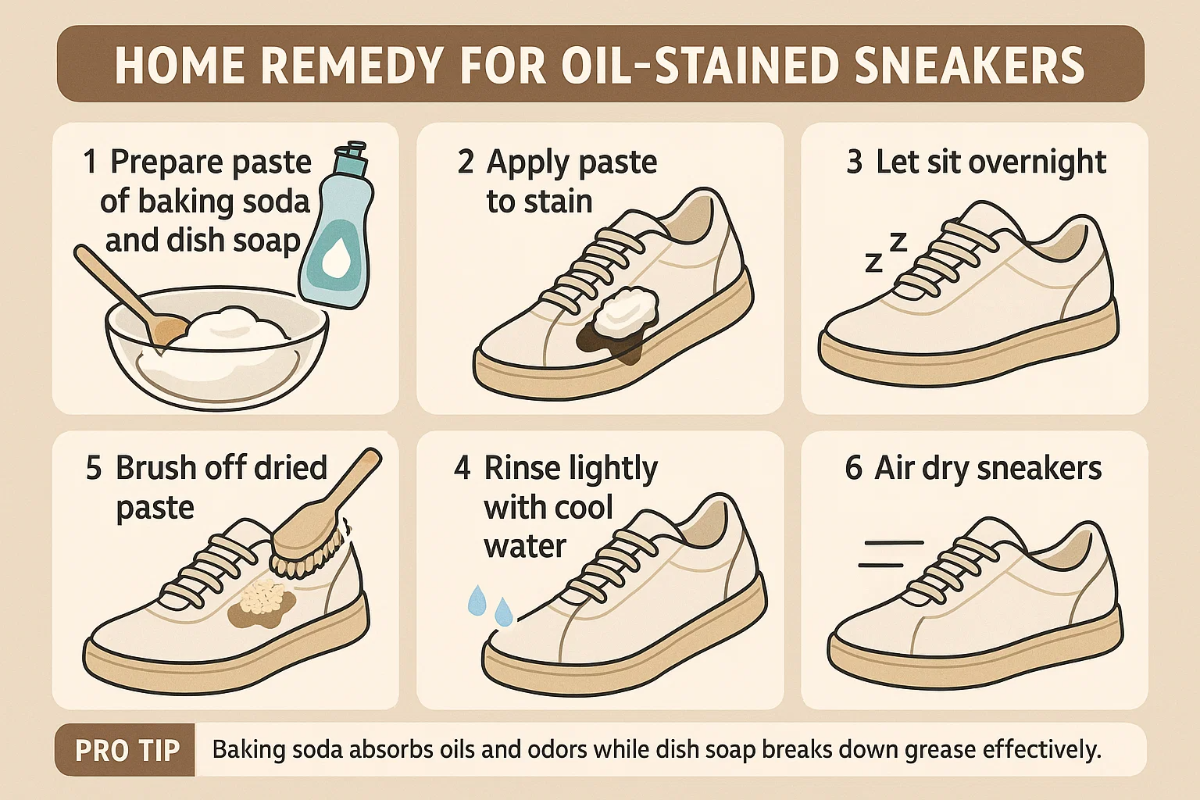
Step 3: Let the Paste Sit Overnight
To give the mixture enough time to penetrate the fabric and absorb the oil, leave the paste on the stain for several hours, preferably overnight. This slow action helps lift the oil without harsh scrubbing that could damage delicate sneaker fabric.
Step 4: Remove the Dried Paste
After the paste has dried, use a soft brush or cloth to gently brush away the residue. Most of the baking soda and loosened oil particles should come off with this step.
Step 5: Rinse the Area Lightly
Once you have brushed off the paste, rinse the stained area lightly with cool water. Avoid soaking the sneakers, as excess water can damage the shoe or cause shrinking and deformation. A gentle rinse will remove any remaining paste or soap residue.
Step 6: Air Dry Your Sneakers
Finally, allow your sneakers to air dry completely in a well-ventilated area, away from direct heat or sunlight. This prevents any shrinkage or fading that can occur from excessive heat exposure.
Why This Method Works
Baking soda naturally absorbs oils and odors, while dish soap breaks down grease molecules effectively. Together, they make an affordable and accessible cleaning solution suitable for fabric sneakers, helping to remove tough stains without damaging the material.
Important Tip:
If the stain persists after the first treatment, repeat the process once or twice before moving to stronger commercial products. Always test any cleaning method on a small, inconspicuous area first to ensure no discoloration or damage occurs.
Remove Cooking Oil Stains from Work Shoes
Spilling cooking oil on your work shoes—especially if you’re in a busy kitchen or hospital—can feel like a nightmare, right? But don’t worry, quick action can save your shoes (and your sanity).
First things first: don’t panic. The moment you notice that slick spot, grab some paper towels and gently blot the oil. Here’s a pro tip: blotting is better than rubbing because rubbing just pushes the oil deeper into the material and spreads it around.
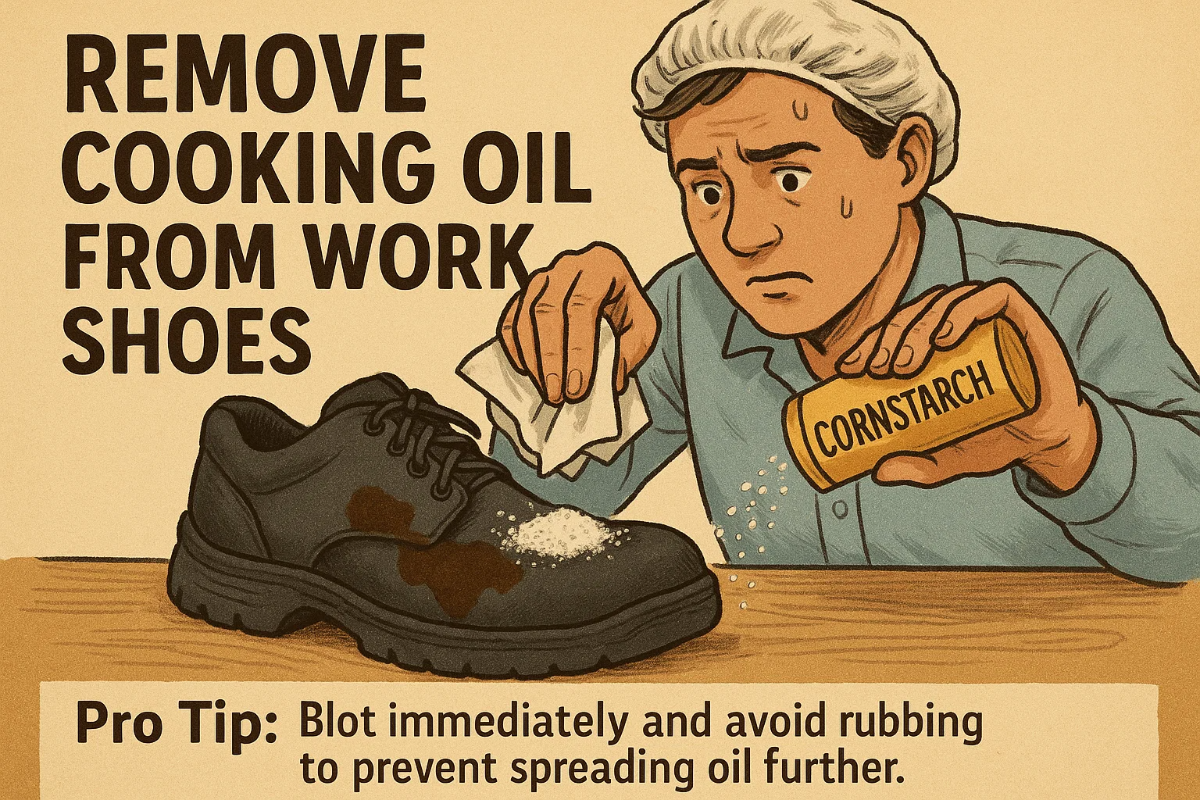
Once you’ve soaked up as much oil as possible, sprinkle some cornstarch or talcum powder over the stain. This step is crucial—it helps absorb the leftover grease and keeps it from sinking further into the fabric or leather. Let the powder sit on your shoe until you can give it a proper clean.
Now, here’s something to really keep in mind: avoid walking around with oily shoes! It’s not just about your shoes getting worse—walking with untreated oil can spread grease onto floors and even other pairs of shoes, creating a bigger mess for you and others.
If you’re ever in a rush and need to remove cooking oil from work shoes on the spot, this simple, quick routine is your best friend.
Post-Cleaning Shoe Care Tips
So, you’ve tackled that stubborn oil stain—great job! But your work isn’t over yet. How you care for your shoes after cleaning can make all the difference in keeping them fresh and long-lasting.
First up: drying. It might be tempting to speed things up with a hairdryer or toss them in the sun, but hold on! Always let your shoes dry naturally, away from direct sunlight or heat sources. Why? Because heat can warp the shape of your shoes or cause materials like leather to crack and fade. Patience here pays off!
If your shoes are leather (or faux leather), don’t forget to apply a good leather conditioner once they’re dry. This step helps restore moisture and keeps your shoes soft and supple, preventing that stiff, cracked look we all dread.
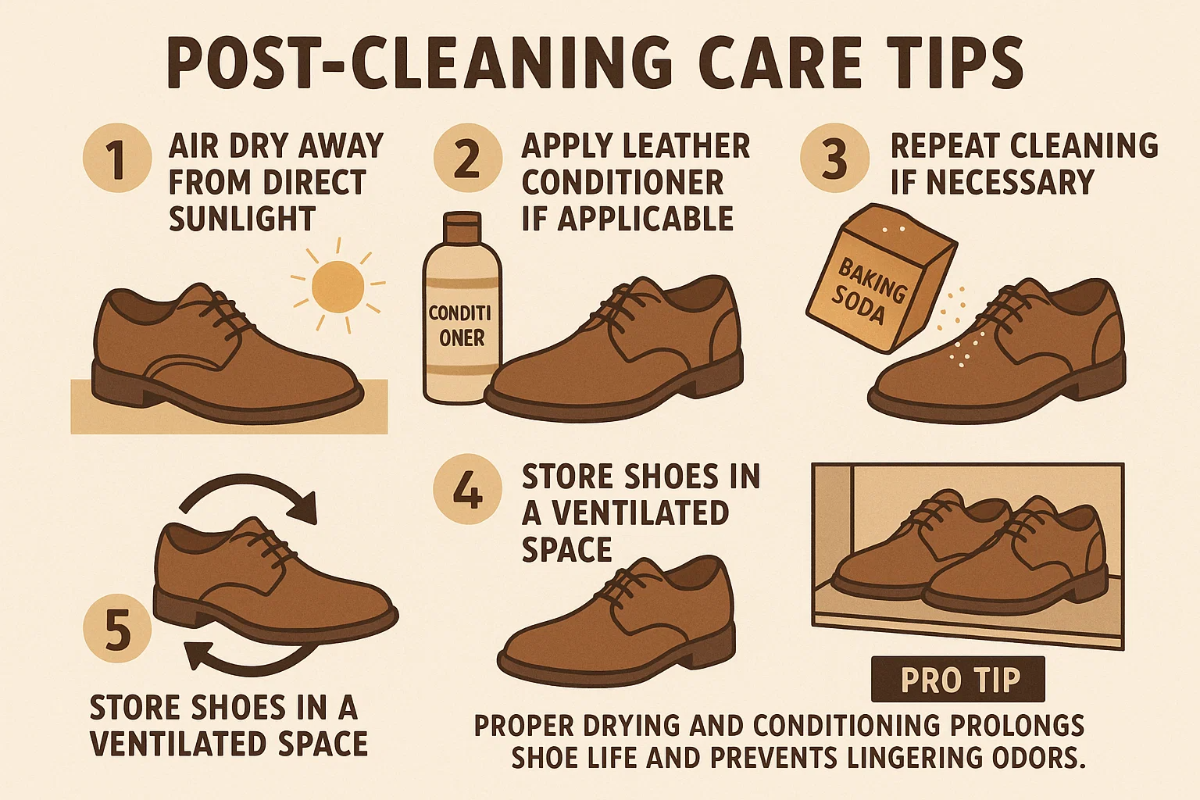
Next, let’s talk about odor. Even after cleaning, shoes can hold onto unpleasant smells. A simple trick? Sprinkle a bit of baking soda inside your shoes overnight to absorb any lingering odors. Or try cedar shoe inserts, which not only fight smell but also keep moisture under control.
Finally, if you still see a faint trace of that pesky stain, don’t hesitate to repeat the cleaning process. Sometimes stains need a couple of treatments to fully disappear, and that’s perfectly okay.
Pro tip: Store your cleaned shoes in a well-ventilated space to keep them fresh longer and ready for your next adventure!
Recommended Products to Remove Oil Stains From Shoes
Product | |
Leather Safe Degreaser | |
Microfiber Cloth | |
Multi Material Shoe Cleaning Kit | |
Baking Soda | |
White Vinegar |
Conclusion
Here’s the secret: To remove oil stains from shoes, you should act ASAP. The faster you act, the better your chances of removing those pesky oil stains. But it’s not just about speed—it’s also about choosing the right cleaning method for the type of shoes you have. Whether you’re dealing with fabric, leather, or synthetic materials, treating your shoes gently and correctly can save your favorite pair from permanent damage.
Remember, stains might seem stubborn, but with patience and the right care, you can bring your shoes back to life. So next time you spot a grease mark, don’t panic—grab your cleaning supplies and give your shoes the TLC they deserve. Your footwear (and your feet!) will thank you.
Ready to learn more about keeping your shoes fresh? Check out our guides on shoe care and cleaning for even more tips!
Related Guides:
FAQs
What removes oil from sneakers quickly?
Blot immediately, apply baking soda, then scrub with dish soap.
Can you use baking soda to clean oil from shoes?
Yes—it absorbs oil before washing, especially for fabric or canvas.
How do you get cooking grease out of leather shoes?
Use talcum powder or a leather-safe degreaser, then condition afterward.
Is dish soap safe on fabric shoes for grease stains?
Yes, use a mild degreasing formula with warm water.
What’s the best DIY way to clean oil from canvas shoes?
Baking soda soak followed by gentle scrubbing with dish soap.

Leave a Reply